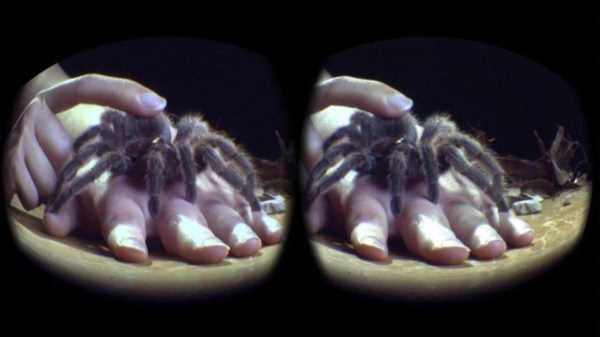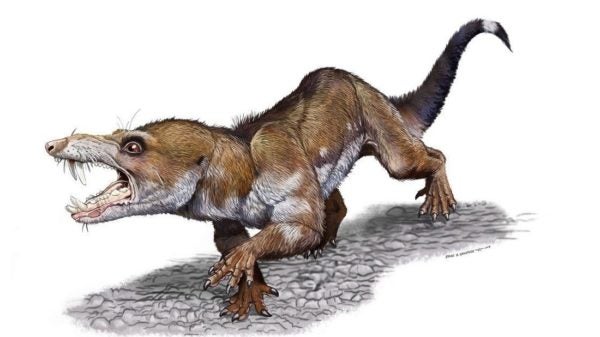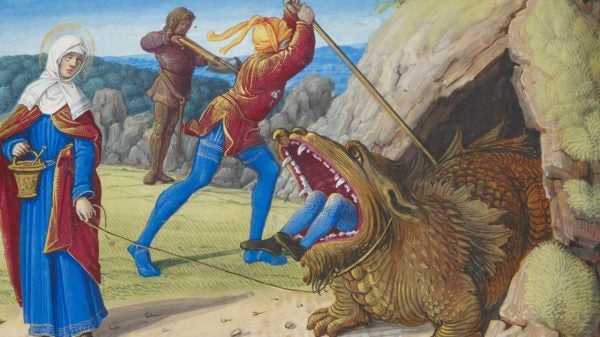It’s that time of the year again — fall is here and so is the season of scares. From VR spiders to terrifying saber-toothed rodents, here are this year’s highlights of creepy research and happenings on and around campus.

Virtual Creepy Crawlies
Imagine you are sitting in a chair. All of a sudden a giant tarantula slowly begins to crawl toward you. You reach forward, trying to swipe it away, but nothing happens. It turns out the spider is just an illusion — created by researchers at The University of Texas at Austin. No, this isn’t torture. This is virtual reality exposure therapy.
In the past, therapy involved using real, living spiders. However, live exposure as a treatment option is difficult to deliver to people who fear things that cannot be easily brought indoors like blood (hemophobia), airplanes (aerophobia) and large animals (zoophobia).
Now, UT researchers from the Department of Psychology and the Institute of Mental Health Research say VR is simpler and maybe just as effective. They used the 3D stereoscopic features of the Oculus Rift to simulate the depth and motion of a spider being held by a model and then slowly crawling toward you. Seventy-seven UT undergraduates in an introductory psychology course who have a fear of these creepy crawlies participated in the study.
After several VR sessions, participants were tested with a live tarantula and were found to have clinically significant improvement, as published in the Journal of Anxiety Disorders. The researchers also compared VR therapy results with another live exposure alternative -— CGI therapy — and found VR had greater improvement possibly due to its ability to stimulate 3D first-person fears, whereas computer-generated imagery is 2D and lacks photorealistic depth. Today, they are continuing to solidify their claims with more experiments and are investigating other applications of virtual reality.

Recurring Fearful Memories
Speaking of phobias, a team of UT neuroscientists from the Center for Learning and Memory have identified a set of neurons that allow disturbing memories to resurface.
According to the researchers, the “extinction neurons” suppress fearful memories when they are activated. When these brain cells are not activated, frightening memories can re-emerge. From this, they found that the hippocampus plays a more important role in compartmentalizing fear than previously assumed.
The scientists were able to artificially invoke fear and suppress the extinction trace memories by activating and deactivating the extinction neurons. This discovery, published in Nature Neuroscience, could ultimately lead to new methods for the treatment of anxiety, phobias and post-traumatic stress disorder (PTSD). Read the full story here.

Specter Stories
Want to be spooked with some ghost stories from the past? Come visit UT Austin’s Briscoe Center for American History. Not only is it a great resource for historical research, it also contains a number of bygone ghostly tales. Read all about the goosebump-inducing specters in the Margaret Berry Papers or get lost in a world of bear hunting, murderers and ghouls with the Robert Pierce Papers. There are even Mexican ghost stories on reel-to-reel tape just waiting to entertain and spook.

Fanged Squirrel
While creepy crawlies are freaky and memories can be nightmarish, at least there are no saber-toothed killer rodents, right?
Not anymore apparently. A fascinating study published this year that includes research from Rachel Wallace, instructor of anatomy at Dell Medical School and Timothy Rowe from UT Jackson School of Geosciences, describes what appears to be a real-life saber-toothed squirrel — only it’s from the Triassic Age.
Recently discovered by paleontologists in Argentina, researchers posit that this 231-million-year-old, fierce-looking mammal relative would have measured about 10 inches from nose to tail, and it hunted smaller animals or insects as prey.

Medieval Monsters: Terrors, Aliens, Wonders
On the topic of monster-like animals, medieval artists oftentimes illustrated their manuscripts with their worst imagined fears — from dragons, fanged beasts and other fabled animals to hybrid creations that combine wings, tails and limbs in inventive ways. These creatures formed an essential part of the European medieval worldview, giving shape to the unknown or embodying cultural fears of the time. The Blanton Museum of Art will host an exhibition on these terrifying beasts starting Oct. 27, so be sure to check it out.
3D Printed Jack-O-Lantern
Like the heading says, students from the UT Cockerell School of Engineering used Texas Inventionworks (formerly Longhorn Maker Studios), one of the many cutting-edge maker spaces across campus where technology helps students build and create their own inventions, to print a 3D jack-o-lantern. Learn more about additional maker studios and their resources here, and have a happy Spooktober!
